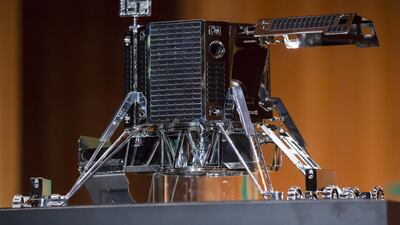Japanese companies are planning to kick-start the lunar economy by backing a local start-up’s mission to land on the moon by 2020.
Tokyo-based Ispace said it raised ¥10.2 billion (Dh441.1 million) from some of the country’s biggest businesses, including Japan Airlines and television network Tokyo Broadcasting System Holdings. The funds will be used to send a spacecraft into lunar orbit by 2019, and then land one a year later.
Private companies are playing a bigger role in space development, from Elon Musk’s rocket launcher Space Exploration Technologies and asteroid miner Planetary Resources, seeking to deliver humanity to the cosmos while securing a return for their shareholders. Ispace says a thriving lunar economy is still decades away, but it is putting profits and corporate projects at the heart of its missions in the coming years.
“Human beings aren’t heading to the stars to become poor,” Takeshi Hakamada, the chief executive of Ispace, said in Tokyo. “That’s why it’s crucial to create an economy in outer space.”
Not all of Ispace’s investors are corporations. Government-backed Innovation Network Corp of Japan is the leading investor in the round with ¥3.5bn, while Development Bank of Japan also invested an undisclosed amount.
Ispace says the initial business opportunity is mostly in marketing, including slapping corporate logos on its spacecrafts and rovers, and delivering images to be used in advertising. A successful landing will also let the company offer what it calls a "projection mapping service" - a small billboard on the moon’s surface. The start-up says there will be demand from corporations looking to show off their logos with Earth in the background.
From 2021, Mr Hakamada plans to land exploration vehicles that will search for water. That in turn can be turned into hydrogen fuel and ultimately perhaps support a lunar settlement.
Ispace estimates there are billions of tonnes of water on the moon, but hard evidence is lacking. In 2009, Nasa researchers found molecules associated with water. This year, a study used satellite data to estimate that large amounts of water likely exist under the surface.
_______________
Read more:
Search for the fantastic four: Sheikh Mohammed begins hunt for first Emirati astronauts
The UAE's mission to build a city on Mars is an ideas race first
_______________
Ispace got its start through Google’s Lunar Xprize, a competition sponsored by Alphabet that will award $20m to whoever can land and drive a spacecraft on the moon’s surface. Established in 2007 with a target date of 2012 for the first mission, the deadline has been repeatedly pushed back as participants faced technical and financial challenges.
Mr Hakamada said Ispace’s goals are mostly independent of his efforts with Team Hakuto, his partner in Google’s competition. He says both projects will continue, but the funding round will seed development of a sustainable business.
Most companies in Google’s competition have similar plans, including Cape Canaveral-based start-up Moon Express, which counts the Chinese gaming giant Tencent among its investors.
Japanese companies have a history of fascination with space. In 2014, Otsuka announced plans to deliver a can of its Pocari Sweat drink to the moon’s surface. In 1990, TBS sent a journalist on a Soviet rocket to the Mir space station.
"Among Series A funding rounds, this one is the biggest ever for Japan and the biggest globally for a space-related start-up," Mr Hakamada said.

